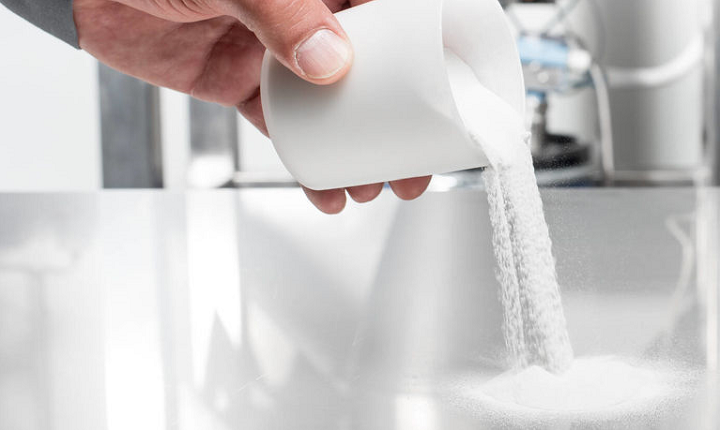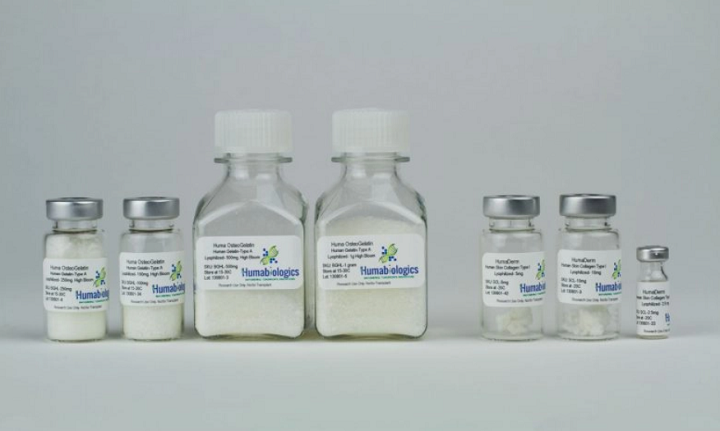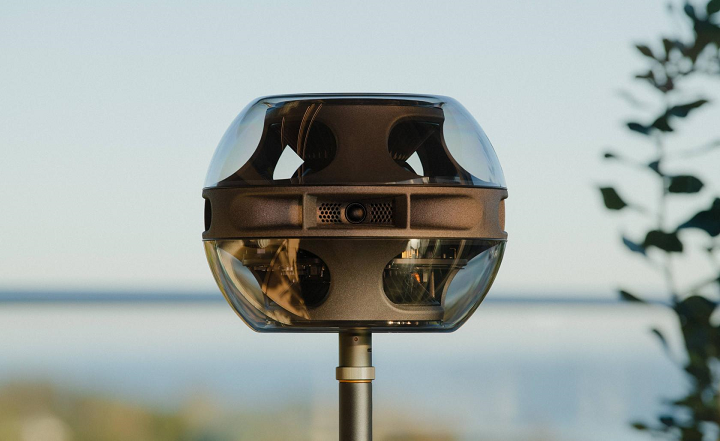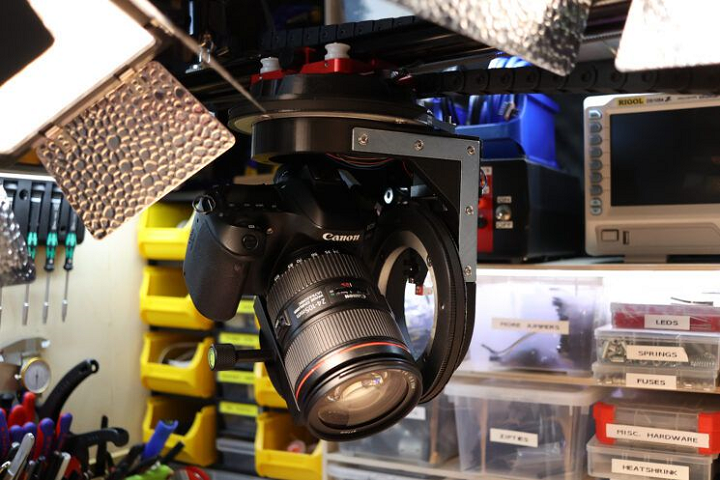3D Printing News Briefs, June 17, 2021: Titomic, Evonik & Farsoon, Humabiologics, UCSD, Syng, FuzzyLogic
Starting with business and then moving on to materials and cool 3D printed products, we’ve got another 3D Printing News Briefs edition for you! Titomic has a new CEO, and Evonik tested out PA 613 for Farsoon’s SLS technology. Humabiologics released a human collagen bioink, and UC San Diego PhD students developed a sustainable, award-winning method for 3D printing steel. Moving on, Syng used 3D printing to create its Cell Alpha Speaker. Finally, a YouTube maker relied on 3D printed parts to make a less expensive DIY motion control rig.
Titomic Names Herbert Koeck New CEO
In November, Jeff Lang, the Founder of Australian company Titomic Limited (ASX: TTT) announced that he was stepping down as CEO, and the company named industrial veteran Norbert Schulze as the interim CEO until a permanent replacement could be found. That day arrived recently, as Titomic revealed that Herbert Koeck, a recognized 3D printing solutions expert, has been appointed by the Board of Directors as its new Chief Executive Officer, effective July 1st, 2021. Schulze will continue to support Titomic in a different role, and this is hopefully the last in a series of recent changes to the company’s Board of Directors. Koeck has spent the last five years as a member of 3D Systems’ executive management team, serving first as Senior Vice President – Europe and India from 2016 to 2017 and Executive Vice President Global Go-To-Market from 2018 to 2021.
“Herbert is a proven leader with deep additive manufacturing experience, hard core marketing skills, business vision and ability to bring people together. His experience in bringing advanced technologies to customers around the world is exactly what Titomic needs as the Company enters its next chapter focusing on commercialising its Cold Spray Additive Manufacturing (‘CSAM’) technology centred on building partnerships as well as joint ventures with customers,” stated Titomic Chairman Dr. Andreas Schwer. “During this exciting time of transformation, Herbert is the right leader at the right time for Titomic. I have the privilege to be the Chairman of Titomic since June 2020 where we have made significant changes and progress in order to position the Company for growth and shareholder value creation. I know the new leadership team, employees, partners, customers and shareholders will all benefit under Herbert’s leadership. On behalf of the Board, I would like to thank Norbert for his outstanding contribution as Interim CEO and in particular his great support in defining the new strategic direction of the Company.”
Evonik Tests PA 613 Material on Farsoon’s SLS Printers
Chemicals company Evonik announced that it has successfully tested its INFINAM PA 6005 P, otherwise known as polyamide or PA 613, on Farsoon’s ST252P and HT403P SLS 3D printers. PA 613 is one of the company’s high-performance polyamide 6 materials, featuring high chemical and temperature resistance, mechanical strength, and water absorption of less than 3%—all of which combine to make the powder not only easier to process but also print parts with great mechanical and dimensional stability and high stiffness. Beyond this material, Evonik and Farsoon are continuing their collaboration in order to develop six other polyamide powder materials.
“Close collaboration between material and machine manufacturers is essential to open up new 3D applications,” commented Wolfgang Diekmann, Director Research, Development & Innovation Additive Manufacturing at Evonik. “The results of our test series are clear: INFINAM PA 6005 P, with its higher melting point of 215°C, can not only be excellently processed on Farsoon’s ST252P and HT403P machines, but also recycled. We used our synergies to develop a market-ready solution.”
Humabiologics Introduces First Commercial Human Collagen Bioinks
Regenerative medicine startup Humabiologics, founded by scientists and tissue industry experts with scientific, quality, regulatory, and technology expertise, has introduced what it says are the world’s first native human collagen bioinks and gelatin bioinks. These bioinks, said to be more “clinically relevant” and affordable, are meant to help with the shortcomings and issues of current animal-derived bioinks, especially in terms of a more realistic response, and help advance the current research. Humabiologics works only with FDA-registered and accredited tissue banks to ensure well-screened donated human tissue for its bioinks, which include extracellular matrix, native human collagen, and bone gelatin and are manufactured using proprietary processes.
“Several renowned research groups have transitioned from using animal biomaterials to human biomaterials due to the superior results and affordability. I have had the honor of working in the tissue and blood banking sector for many years and have witnessed firsthand the impact of how hundreds of people can enjoy their lives with their loved ones because of the courageous gift of organ, tissue, eye and blood from donor heroes,” said Mohammad Albanna, the company’s CEO and Adjunct Professor of General Surgery at the Wake Forest University School of Medicine. “Humabiologics is among the few companies, if not the only company, in the world that partners with tissue banks to give the gift of tissue donation a new and bigger life when transplant is not possible. We bridge the gap between donated human tissues and medical research by providing native human-derived biomaterials that are more clinically & physiologically relevant to develop new therapies. We provide products that have long been needed but unfortunately were not accessible to researchers. Humabiologics introduced the world’s first native human bioinks.”
To learn more about the creation and successful use of the first native human collagen bioink, check out this paper published by Vipuil Kishore’s team—which includes Albanna—at Florida Institute of Technology (FIT). By using lyophilized collagen derived from human skin, the researchers were able to tailor its properties to meet specific therapy needs.
3D Printing Steel Sustainably at Triton Innovation Challenge

Jacobs School of Engineering materials science PhD students Andy Zhao and Olivia Dippo are the founders of Green Steel Printing, which won Grand Prize at the Triton Innovation Challenge.
Hosted by UC San Diego’s Jacobs School of Engineering, Rady School of Management, and Scripps Institution of Oceanography, the Triton Innovation Challenge is a business competition that highlights creativity and environmentally-focused, commercially promising technologies created by the university’s students, staff, and faculty. Recently, at the ninth annual competition, five teams virtually presented their ventures to an audience and panel of judges, and Green Steel Printing, founded by Jacobs School of Engineering materials science PhD students Olivia Dippo and Andy Zhao, won the $7,000 Grand Prize for their sustainable, less expensive method of 3D printing steel. Typically, subtractive processes are used to manufacture steel parts, burning either natural gas or coal to reduce iron oxide ore into iron before it’s converted into steel, which causes a lot of scrap metal waste and accounts for 7% of global carbon dioxide emissions. The startup combines a patent-pending metal 3D printing process with green hydrogen technology to general steel with no carbon emissions and much less wasted scrap metal.
Dippo explained, “Inspired by metal 3D printing and inspired by using green hydrogen as a replacement for fossil fuels, we have come up with our Green Steel printer. The two inputs are iron oxide ore—which is how the material comes out of the earth—and green hydrogen. These two things are mixed together in a reaction zone that forms iron powder. We can add additional alloying elements such as carbon in order to make steel, and at the very bottom of the machine we have our print head, where we can print the desired shapes.”
Green Steel Printing is working to secure more funding and lab space to continue developing their steel 3D printer, with the goal of a completed prototype in a year.
Cell Alpha Smart Speaker Made with 3D Printing
Three years ago, Damon Way, the founder of DC Shoes, and Christopher Stringer, a former Apple product designer, founded next-generation audio company Syng, and recently introduced its innovative Cell Alpha Speaker, which features the company’s smart Triphonic sound technology and sits on an adjustable metal stand. This device actually learns the acoustics of a space in order to help shape the sound it delivers, and the three-horned Triphone at the center of the transparent speaker, which was made using 3D printing, comes with Force-Balanced subwoofers that optimize bass quality at any volume. Stringer explained that the company wanted to shape culture as well as sound in its flagship Cell Alpha Speaker system.
“Triphonic encompasses technologies in both hardware and software to fulfill our vision. There are all shapes and sizes of rooms, and all kinds of audio types from mono, via stereo, to an enormous range of spatial formats. This is essentially the problem statement and Triphonic technology is the solution. We can understand the physical characteristics of the room and the placement of the Cell or Cells within it to tune the sound and map the Cells in your space. We also know the shape of how sound is laid out in any type of content and essentially map the sound experience to your space,” Stringer continued.
“At the core of the design are eight custom drivers. These are finely tuned to our specifications to work in harmony as a system. Building out from the source of the sound, the enclosure is an entirely new speaker architecture. This is most evident in two prominent details, firstly in the manner of how we mount the Cell in space, and secondly the use of 3D printing in producing the Triphone, our three-horned sound projector…
“For a super robust structure, the post extends through the bottom woofer to the heaviest part of the system, the drivers. This is where the 3D printed part picks up the structural load in suspending the enclosure from this anchoring point at centre. The Triphone is of a nature and form that defies traditional manufacturing. It was really important structurally for it to be a single part, for sound to have complex uninterrupted pathways and for it to carry all of the individual seals for the system. Simply put, all of the complexity is focused in a single part and the balance of parts is as simple as possible.”
You can purchase Syng’s Cell Alpha Speaker for $1,799.
3D Printed Motion Control Rig
Maker Andreas Epp, known as FuzzyLogic on YouTube, used 3D printing to create a motion control rig that’s said to offer “pro-level features at a DIY-level price.” The 3-axis system features a pan-tilt head and a slider, which can be pretty tricky to make, especially when 3D printed parts are involved. But Epp was more than up to the challenge, using several complex design features like fancy slip rings, slewing bearings similar to what’s used in a lazy susan, and optical stop ends—allowing the rig to reset while still providing over 360° of rotation—that aren’t often seen in DIY solutions. Epp also created a 4th axis through a panning rotary plate that connects to everything else, making it easy to repeat moves from the slider and pan-tilt head, and even introducing the possibility of using the rig to 3D scan small things through photogrammetry. He’s improved the system over the past year of work, and now uses much less material to print the parts, which also makes the rig more lightweight and less expensive to create.
“Not only is it a thing of mechanical beauty, but it also seems to rival many commercially available systems out there, too,” John Aldred wrote for Photography.
If you’re interested in making your own version of this motion control rig, Epp has made all of the code files and STLs available for download from GitLab.
Subscribe to Our Email Newsletter
Stay up-to-date on all the latest news from the 3D printing industry and receive information and offers from third party vendors.
You May Also Like
Further Understanding of 3D Printing Design at ADDITIV Design World
ADDITIV is back once again! This time, the virtual platform for additive manufacturing will be holding the first-ever edition of ADDITIV Design World on May 23rd from 9:00 AM –...
3D Printer Maker EVO-tech Reborn as NEVO3D — Once More With Feeling
EVO-tech was a 3D printing service and original equipment manufacturer established in 2013 and based in Schörfling am Attersee, Austria. The company produced high-quality material extrusion systems featuring linear bearings,...
3D Systems Brings 3D Printed PEEK Cranial Implant to the U.S. with FDA Clearance
For more than 10 years, 3D Systems (NYSE:DDD) has worked hand-in-hand with surgeons to plan over 150,000 patient-specific cases, and develop more than two million instruments and implants from its...
CDFAM Returns to Berlin for Second Annual Symposium
The second CDFAM Computational Design Symposium is scheduled for May 7-8, 2024, in Berlin, and will convene leading experts in computational design across all scales. Building upon the first event...




































